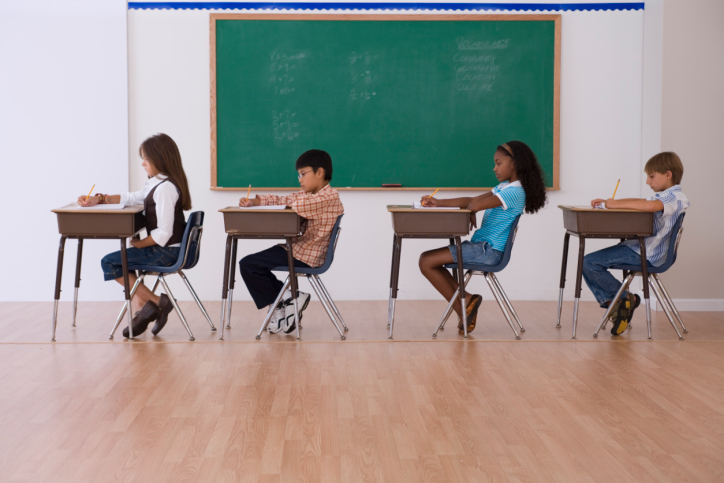Over the summer of ’03, the Nation’s Report Card brought home tons of new data on the reading and writing prowess of America’s fourth-, eighth-, and 12th-graders. As is often the case with the National Assessment of Educational Progress (NAEP), the results are a mixed bag, subject to differing interpretations.
In general, the bright spots in the 2002 testing came in the fourth grade and in near-term comparisons. The disturbing numbers were for high school seniors and performance comparisons over a longer period of time.
Specifically, reading and writing achievement of fourth-graders improved significantly since 1998. Eighth-grade writing also improved over this four-year period, though reading scores were generally flat. That was the good news. The bad news was for the 12th grade, where achievement tanked.
Grounds for Optimism
On reading, a subject critical to future learning, U.S. Secretary of Education Rod Paige found some grounds for optimism.
“We can celebrate,” he said, “because the average fourth-grader’s reading score has improved over the past four years and the average eighth-grader’s reading score is higher than it was in 1992, when the current National Assessment of Educational Progress was first given.”
Paige also found cause to cheer from the following statistical comparisons: In the most recent testing, black fourth-graders narrowed the achievement gap from 1994 with their white peers, while Hispanic fourth-graders narrowed their gap from the 2000 testing with their white counterparts. Low-income children also showed improvements.
From such data, Paige drew hope that federal No Child Left Behind (NCLB) accountability will yield further gains. Under NCLB, states must test students annually in grades 3-8 in reading and mathematics, with a daunting goal of 100 percent proficiency by 2013. The states will use tests of their own choosing, but for the first time they must also participate in NAEP.
“At the same time,” added Paige, “I’m concerned that not a lot has changed since 1992, when this NAEP assessment [in reading], the most comprehensive, challenging ever, was first given. At the national level, fourth-graders are scoring at about the same level, eighth-graders are scoring a bit higher, and 12th-graders have gone south.”
Desired Standard Is “Proficient”
The desired standard for all students in the NAEP rankings is “proficient,” a mark that is supposed to reflect “solid academic performance.” The “basic” level denotes only “partial mastery” of basic skills, and “advanced”–a level attained by tiny percentages of NAEP takers–means superior performance.
The Nation’s Report Card was good news in some quarters. At all three grades, students in private schools had higher average reading scores than did public school students. Among high school seniors, the private school advantage reached 19 points on a 300-point scale. Scores for students in Department of Defense schools for dependents of military personnel were among the highest in the rankings, and black and Hispanic children in those schools on average scored 17 to 23 points higher than their peers nationally.
Looking at the big picture, only about one-third of American children are reaching the proficient level, if NAEP’s sampling is credible. NAEP has its critics, but most experts deem it the most accurate gauge of grade-school achievement the U.S. currently has.
12th-Grade Reading Proficiency Drops
On the reading test, the proportion of fourth-graders attaining proficient rose from 29 percent to 31 percent over the past four years, while the proportion of high school seniors reaching proficiently dipped from 40 percent to 36 percent.
Some analysts believe the school reform movement has neglected high school in its emphasis on early learning. Others believe that the increased attention being given to teaching children to read in the primary grades will build a foundation for eventual improvement through to high school graduation.
Writing scores were a bit better than reading scores, but NAEP writing tests were given for the first time in 1998; thus, there is less basis for judging long-term trends on writing than on reading.
Average fourth-grade writing scores went up from 150 to 154 points over the four-year period, while eighth-graders’ scores increased from 150 to 153. Meanwhile, continuing the pattern of disappointing performance by older students, 12th-grade scores dropped from 150 to 148, a change that was statistically insignificant.
Widening Gender Gap Favors Girls
One of the most stunning results of NAEP writing was the ever-widening “gender gap”–one favoring the girls.
On the 2002 writing tests, girls outperformed boys by 17 points at the fourth grade, 21 points at the eighth grade, and 25 points as high school seniors. While the portion of 12th-grade males who attained proficiency in writing stayed at 14 percent, the portion of females reaching that level of solid performance climbed from 29 percent to 33 percent.
Robert Holland is a senior fellow at the Lexington Institute, a public policy think tank in Arlington, Virginia. His email address is [email protected].
For more information …
The reports of the National Assessment of Educational Progress are available at http://nces.ed.gov/nationsreportcard.




